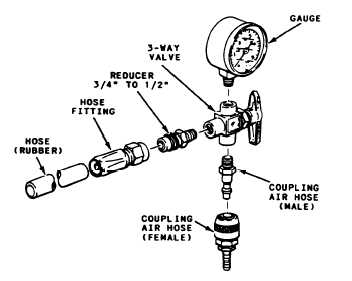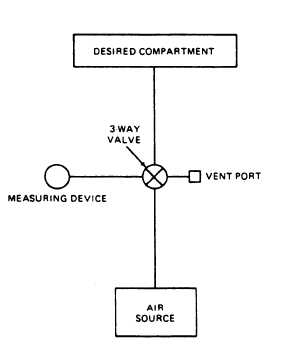FUNCTIONAL TESTING
Before you attempt to perform a functional
test, you should ensure that the work area
surrounding the preserver is free of all foreign
objects. This is done to prevent any accidental
damage to the life preserver. When you perform
a functional check, you want to ensure that the
system operates as if the aircrew member were
using it in an emergency. Therefore, your first step
is to pull the actuation toggle.
The preserver should fully inflate to its design
shape without any evidence of restriction in less
than 30 seconds. If the preserver does not meet
this requirement, you will have to determine the
reason and correct it. To do this, first look at your
stem and valve. Sometimes dirt or foreign matter
can cause a slow inflation. If you make any
corrections, the preserver is functionally tested
again.
Deflate the preserver by using a vacuum
pump and a 3/8- or 1/2-inch inside diameter
rubber hose. Attach one end of the rubber hose
to the vacuum pump, and the other end will go
to the oral inflation valve or to the carbon
dioxide cylinder valve, depending on which type
you are using. After the preserver has been
completely deflated, release the oral inflation
valve or put the CO2 cylinder back into the valve.
The functional check is only performed when
the preserver is placed into service and every
fourth calendar check after that.
LEAKAGE TEST
All life preservers are subjected to a leakage
test each calendar/phase inspection. This test is
performed each time the preserver comes into be
checked, even when a functional test is required.
A special test fixture is needed to perform this
test.
Test Fixture
A suggested test fixture, consisting of a three-
way valve, pressure gauge, and adapters for
compartments being tested, is shown in figure
6-16. The fixture must be fabricated to meet the
requirements of the schematic shown in figure
6-17.
239.471
Figure 6-16.—Leakage test fixture life preserver.
Figure 6-17.—Test rig schematic.
Test Procedure
To test life preservers, proceed as follows:
1. Ensure all carbon dioxide has been
removed from any preserver that has been
functionally tested.
2. To test the LPU-28/P life preserver, insert
a 3/4-inch O.D. rubber hose into the oral inflation
6-30




